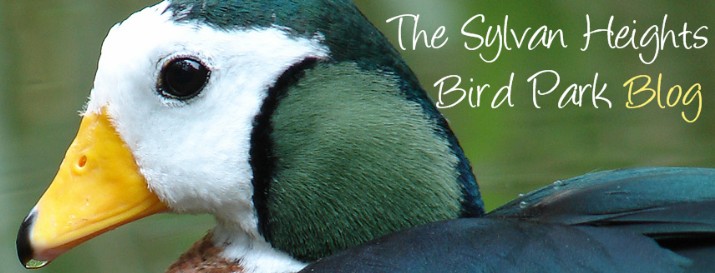If you haven’t had a chance to stop by the park and see our new tree house, now is an excellent time. The mad heat of summer has ended, only to be replaced by gorgeous weather that makes wandering through the park a heavenly treat. And visitors are not the only ones enjoying the cooler temperatures. Everywhere you look, the park’s residents seem to have awakened from their summer slumber and have begun their social dances; birds are splashing in the water, flying around the aviaries, and vocalizing to one another.
The new tree house is a special place, allowing anyone who enters a bird’s eye view of the wetlands below. Songbirds flit among the trees at eye-level, as well as ruby-throated hummingbirds, some of who take an occasional interest in the tree house visitors.
But along the path to the tree house, visitors are in for a surprise when they pass the new building housing restrooms. What’s that you say? A surprise in the restroom? Well…sort of. As you enter the building, you’ll find a small foyer displaying three exhibits: carnivorous plants, a live beehive, and poison dart frogs!

All three are fascinating (seriously, who doesn’t love a good Venus Flytrap?) and worth the stop. The most popular exhibit may be, though, the one housing the Blue Poison Dart Frogs (
Dendrobates azureus). These active little frogs are quickly becoming a park favorite. Unlike most amphibians, these frogs are diurnal, or active during the day, and their bright blue color is stunning.
Despite their name, these frogs are, in fact, NOT poisonous. Not in captivity anyway. According to scientists, their toxicity is apparently derived from their diet in the wild. It’s possible that the ants, termites and beetles that they consume are, in turn, carrying plant poisons from their own diets. Here at the park, the frogs are fed a diet of fruit flies and pinhead crickets for the most part.
Found on only a few small islands of Southern Surinam, the
azureus prefer to live near small streams with heavy vegetation – including moss, lichens and such. Their vivid coloration serves as a warning by signaling their toxicity to potential predators. (However, the only natural predator of most of the poison dart frog family is a snake called Leimadophis epinephelus, which has developed a resistance to the frogs' poison.)
They are proficient climbers, so when you are looking at the exhibit, be sure you look up towards the top as well as the crevices under the rocks and logs. These frogs are fascinating to watch, because they are usually very active. In addition, the often seem to “walk” on all fours, instead of the typical hopping behavior that most fogs use. Surprisingly, they are not great swimmers, so the water level of their pool is deliberately kept shallow.
The frogs have an elaborate courtship that begins with the male vocalizing to attract a female. If she is receptive, the female will then stroke the male’s back with her front legs and follow him around until they find a suitable nesting area. After laying her eggs, the male will guard the nest and even add water to the clutch to hydrate them. About two weeks later when the eggs hatch, the male will crouch down, allowing a few tadpoles to wriggle upon his back and then carry them to a water-filled cavity to continue their development.
For more fascinating information about poison dart frogs, check out
http://www.blackjungle.com/.























.jpg)



